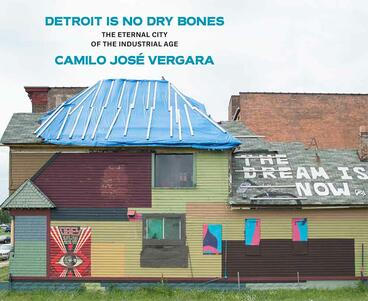Detroit Is No Dry Bones
The Eternal City of the Industrial Age
A photographic record of almost three decades of Detroit’s changing urban fabric
Description
Over the past 25 years, award-winning ethnographer and photographer Camilo José Vergara has traveled annually to Detroit to document not only the city’s precipitous decline but also how its residents have survived. From the 1970s through the 1990s, changes in Detroit were almost all for the worse, as the fabric of the city was erased through neglect and abandonment. But over the last decade, Detroit has seen the beginnings of a positive transformation, and the photography in Detroit Is No Dry Bones provides unique documentation of the revival and its urbanistic possibilities. Beyond the fate of the city’s buildings themselves, Vergara’s camera has consistently sought to capture the distinct culture of this largely African American city. The photographs in this book, for example, are organized in part around the way people have re-used and re-purposed structures from the past. Vergara is unique in his documentation of local churches that have re-occupied old bank buildings and other impressive structures from the past and turned them into something unexpectedly powerful architecturally as well as spiritually.
Camilo José Vergara was named a MacArthur Foundation Fellow in 2002 and received a Berlin Prize Fellowship in 2010. In 2013, he became the first photographer to be awarded the National Humanities Medal. He is author of numerous books, including Silent Cities: The Evolution of the American Cemetery; The New American Ghetto; and Harlem: The Unmaking of a Ghetto.
Reviews
“Vergara is especially alert to changes in the urban landscape . . . perhaps more people will take a second, closer look at the wealth of native folk art we have all over town. And Vergara deserves thanks for recording them and offering a serious critical appraisal.”
—Detroit Metro Times
"The photos are obviously the bulk of the book, and Vergara is a talented visual storyteller, but the book also features chapters that give the images context. Interviews with locals and stories about the way old buildings have been repurposed offer hints about Detroit’s revival. Detroit is No Dry Bones not only depicts the past and present but also considers the city’s future."
- Jeff Fleicher
--Foreword Reviews
"Detroit is No Dry Bones, zooms right in on the city as a rich library of DIY artifacts. Plus, given an eye for art history and as the recipient of a MacArthur genius grant, [Camilo Vegara] easily straddles the line between “New Detroit” and the old neighborhoods."
- Detroit Metro Times
--Detroit Metro Times
News, Reviews, Interviews
Read: Camilo Vergara piece in The Guardian Link | 2/25/2019 Read: Camilo Vergara piece in The Nation Link | 2/25/2019 Read: Camilo Vergara piece in CityLab Link | 3/21/2018 Read: Camilo Vergara piece on Detroit in Public Books Link | 3/22/2018 Read: Camilo Vergara interviewed in the Detroit Metro Times Link | 12/4/2017 Read: Camilo Vergara piece in CityLab Link | 5/6/2017 Read: Detroit is No Dry Bones featured in Co.Design Link | 7/19/2017 Read: Detroit is No Dry Bones featured in The Architect's Newspaper Link | 6/29/2017 Read: Detroit is No Dry Bones featured in Hour Detroit Link | 6/8/2017 Read: Excerpt of Detroit is No Dry Bones featured on Metropolis Link | 4/24/2017 Read: Camilo Vergara in L'Oeil de la Photographie Link | 3/6/2017 Read: Camilo Vergara in Archidose Link | 2/28/2017 Read: Camilo Vergara in The Michigan Daily Link | 2/15/2017 Read: Camilo Vergara in Deadline Detroit Link | 1/26/2017 Read: Camilo Vergara in Detroit Metro Times Link | 1/25/2017 Read: Camilo Vergara in Detroit News Link | 1/25/2017 Read: Camilo Vergara in Archinect Link | 1/17/2017 Read: Camilo Vergara in the LA Times Link | 1/15/2017 Read: Camilo Vergara in the Detroit Metro Times Link | 11/23/2016 Read: Camilo Vergara in the Daily Mail Link | 11/13/2016 Read: Camilo Vergara in the Huffington Post Link | 9/12/2016 Read: Camilo Vergara in The Nation Link | 7/6/2016 Read: Camilo Vergara in the Huffington Post Link | 4/7/2016 Read: Camilo Vergara in the LA Times Link | 4/3/2016

